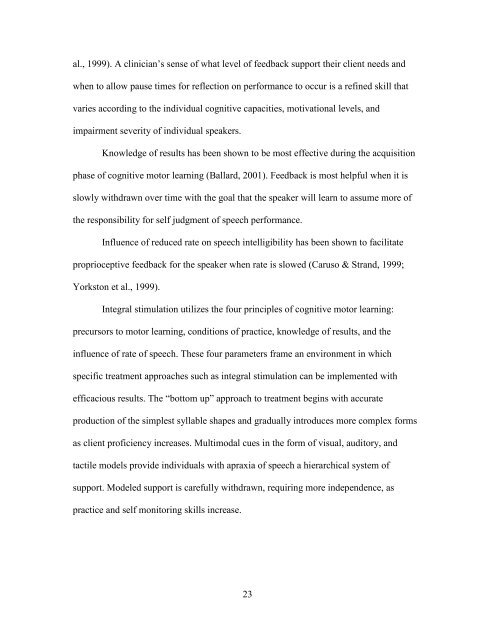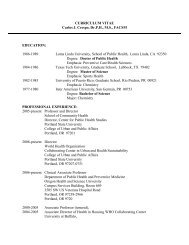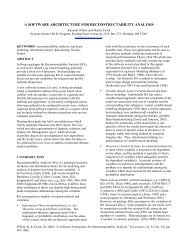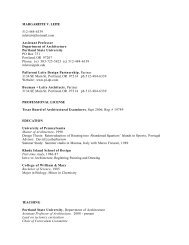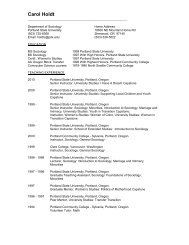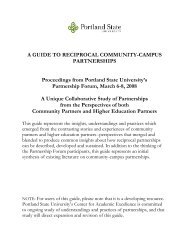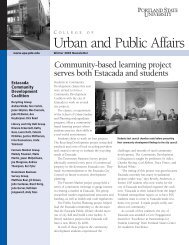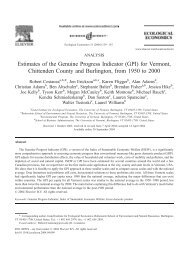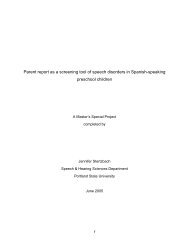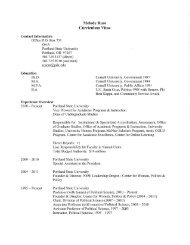Effects of integral stimulation therapy on speech - Portland State ...
Effects of integral stimulation therapy on speech - Portland State ...
Effects of integral stimulation therapy on speech - Portland State ...
Create successful ePaper yourself
Turn your PDF publications into a flip-book with our unique Google optimized e-Paper software.
al., 1999). A clinician’s sense <str<strong>on</strong>g>of</str<strong>on</strong>g> what level <str<strong>on</strong>g>of</str<strong>on</strong>g> feedback support their client needs and<br />
when to allow pause times for reflecti<strong>on</strong> <strong>on</strong> performance to occur is a refined skill that<br />
varies according to the individual cognitive capacities, motivati<strong>on</strong>al levels, and<br />
impairment severity <str<strong>on</strong>g>of</str<strong>on</strong>g> individual speakers.<br />
Knowledge <str<strong>on</strong>g>of</str<strong>on</strong>g> results has been shown to be most effective during the acquisiti<strong>on</strong><br />
phase <str<strong>on</strong>g>of</str<strong>on</strong>g> cognitive motor learning (Ballard, 2001). Feedback is most helpful when it is<br />
slowly withdrawn over time with the goal that the speaker will learn to assume more <str<strong>on</strong>g>of</str<strong>on</strong>g><br />
the resp<strong>on</strong>sibility for self judgment <str<strong>on</strong>g>of</str<strong>on</strong>g> <strong>speech</strong> performance.<br />
Influence <str<strong>on</strong>g>of</str<strong>on</strong>g> reduced rate <strong>on</strong> <strong>speech</strong> intelligibility has been shown to facilitate<br />
proprioceptive feedback for the speaker when rate is slowed (Caruso & Strand, 1999;<br />
Yorkst<strong>on</strong> et al., 1999).<br />
Integral <str<strong>on</strong>g>stimulati<strong>on</strong></str<strong>on</strong>g> utilizes the four principles <str<strong>on</strong>g>of</str<strong>on</strong>g> cognitive motor learning:<br />
precursors to motor learning, c<strong>on</strong>diti<strong>on</strong>s <str<strong>on</strong>g>of</str<strong>on</strong>g> practice, knowledge <str<strong>on</strong>g>of</str<strong>on</strong>g> results, and the<br />
influence <str<strong>on</strong>g>of</str<strong>on</strong>g> rate <str<strong>on</strong>g>of</str<strong>on</strong>g> <strong>speech</strong>. These four parameters frame an envir<strong>on</strong>ment in which<br />
specific treatment approaches such as <str<strong>on</strong>g>integral</str<strong>on</strong>g> <str<strong>on</strong>g>stimulati<strong>on</strong></str<strong>on</strong>g> can be implemented with<br />
efficacious results. The “bottom up” approach to treatment begins with accurate<br />
producti<strong>on</strong> <str<strong>on</strong>g>of</str<strong>on</strong>g> the simplest syllable shapes and gradually introduces more complex forms<br />
as client pr<str<strong>on</strong>g>of</str<strong>on</strong>g>iciency increases. Multimodal cues in the form <str<strong>on</strong>g>of</str<strong>on</strong>g> visual, auditory, and<br />
tactile models provide individuals with apraxia <str<strong>on</strong>g>of</str<strong>on</strong>g> <strong>speech</strong> a hierarchical system <str<strong>on</strong>g>of</str<strong>on</strong>g><br />
support. Modeled support is carefully withdrawn, requiring more independence, as<br />
practice and self m<strong>on</strong>itoring skills increase.<br />
23


